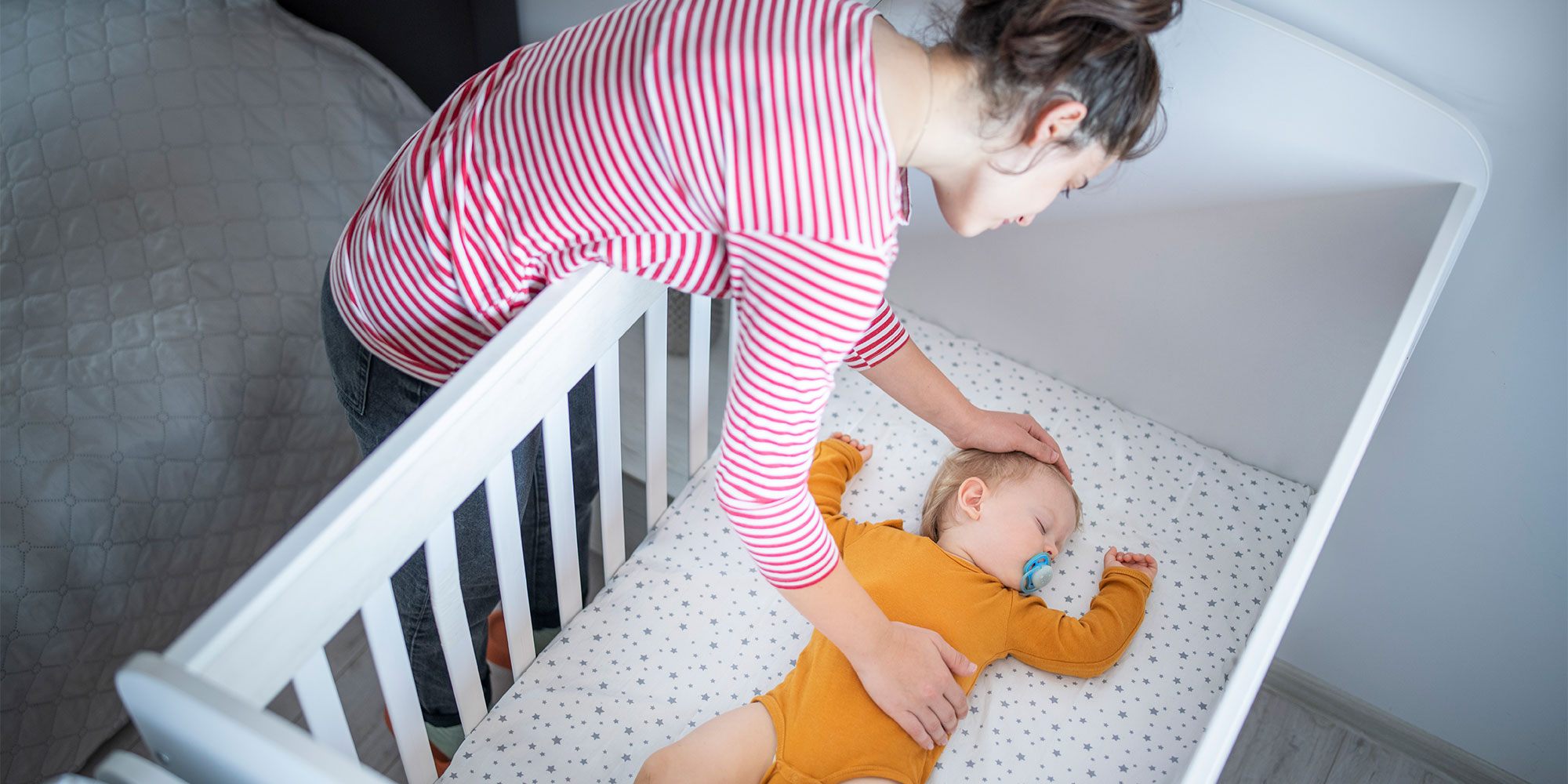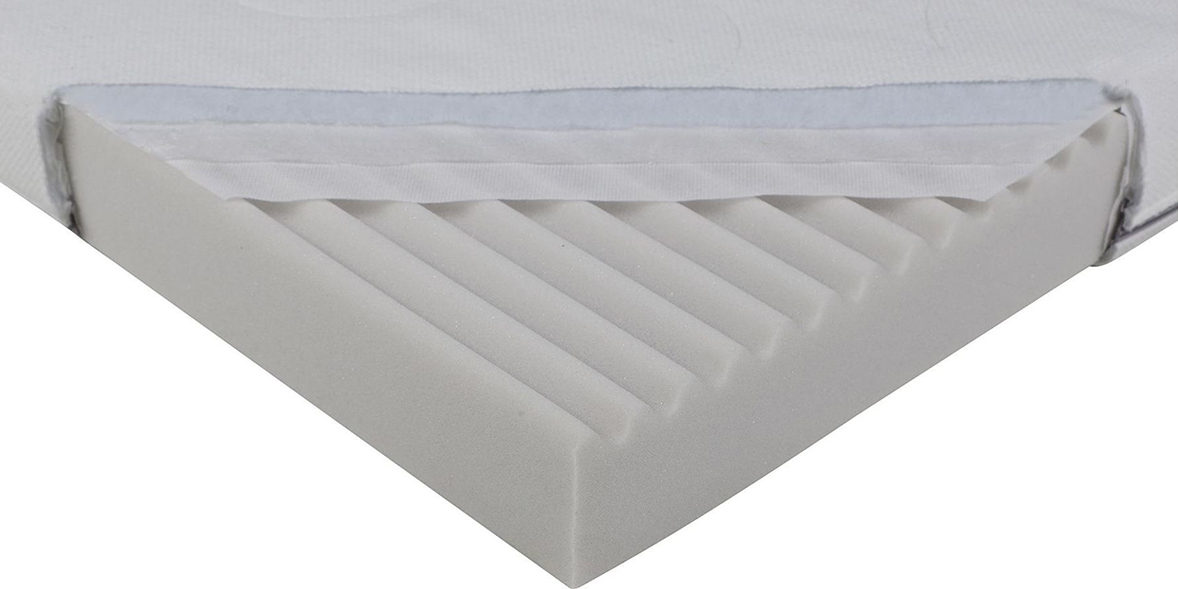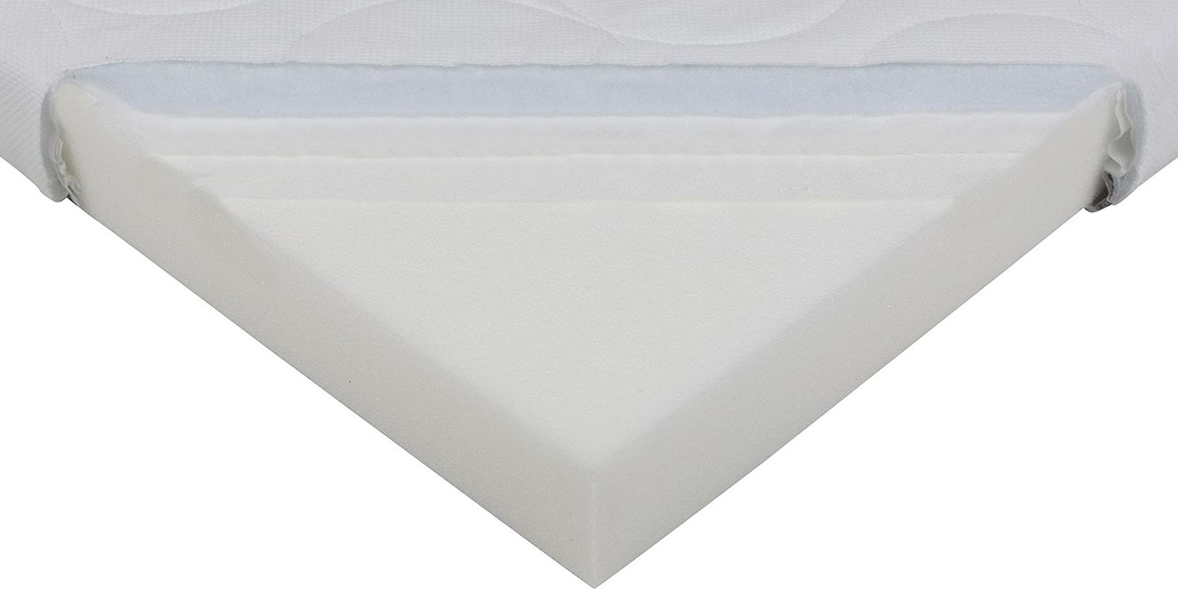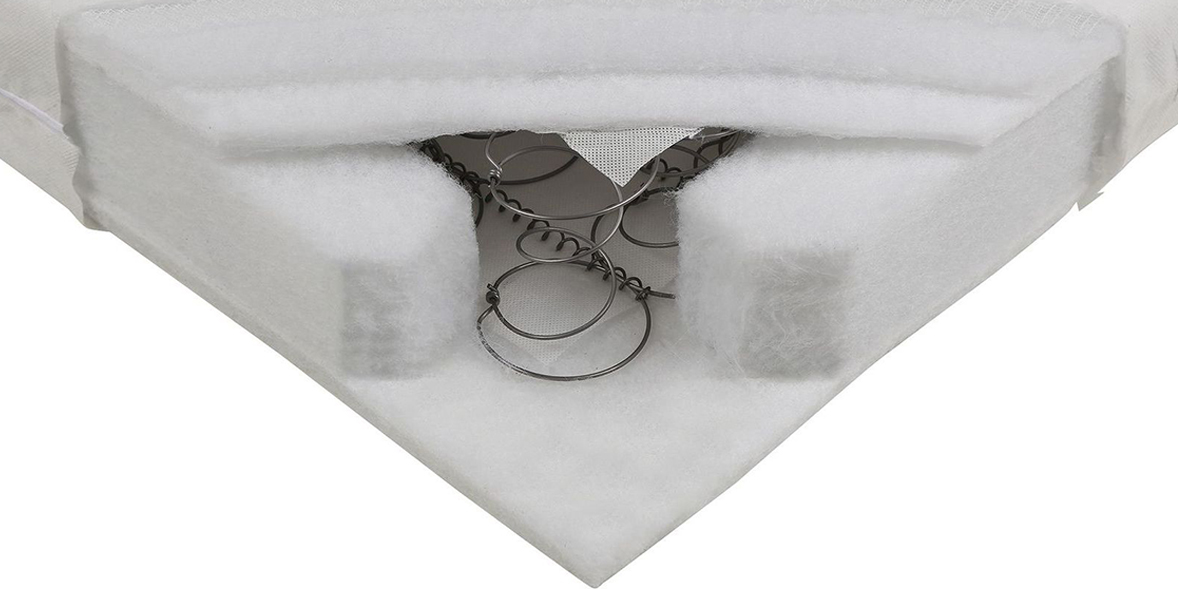By clicking a retailer link you consent to third-party cookies that track your onward journey. This enables W? to receive an affiliate commission if you make a purchase, which supports our mission to be the UK's consumer champion.
Best cot mattresses: expert picks from our safety tests

You need your cot mattress to be able to cope with inevitable accidents, and you need it to last until your child is ready for their first bed. We've found some that are too soft, not breathable and that won't last long enough.
We've tested dozens of cot mattresses over the years from brands including Ikea, John Lewis, Mamas & Papas and Silentnight. Our lab tests assess body support, durability and hazards, to make sure the cot mattress will provide a comfortable, supportive and safe sleeping surface for your little one.
Safety is a crucial part of our assessments and all models are tested to the latest version of the cot mattress safety standard (2021). The cot mattresses are for a standard UK cot bed and measure 140 x 70cm.
How our tests find you the best
Body support
Your baby will grow quickly, so we use a 12kg and a 21kg dummy to see how well it copes with the changing weight and supports your child at different stages.
Durability
Our tests replicate two to three years of use to see if the cot mattress loses firmness or sags and will need replacing before your child has grown out of using it.
Ease of cleaning
You want to make sure the cover is easy to remove in the middle of the night, wash and put back on again, so your baby isn't lying on a dirty, damp mattress.
We also test...
Our safety tests include checking dangers such as choking and swallowing hazards, as well as entrapment and suffocation risks, to give you peace of mind.
The best cot mattresses from our tests
Only logged-in Which? members can view the cot mattress test results below.
Join Which? to get instant access to our test results and Best Buy recommendations below.
| Cot mattress | Price | Score | Type | Performance* | Safety | Durability |
|---|---|---|---|---|---|---|
Sign up to reveal Get instant access to this and all our scores and recommendations. Unlock tableFirst month £5, then £11.99 per month, cancel at any time Already a member? Log in | 76% | Bonnell spring with foam | ||||
| 76% | Pocket spring with coir and latex | |||||
| 75% | Pocket spring | n/a** | ||||
| 73% | Fibre mattress | |||||
| 73% | Foam | |||||
| 72% | Pocket spring | |||||
| 71% | Foam | |||||
| 71% | Pocket spring and foam | |||||
| 68% | Hybrid | |||||
M | 66% | |||||
| 63% | High-resilience polyurethane foam (cold foam) | |||||
| 44% | Foam | |||||
| 43% | Spring | |||||
| 43% | Pocket spring | |||||
| 41% | Spring | |||||
| 38% | Foam | |||||
| 38% | Pocket spring | |||||
| 37% | Latex mat | |||||
| 34% | Coco mat | |||||
| 33% | Fibre | |||||
| 28% | Mesh sleep surface | |||||
| 26% | Spring | |||||
| 25% | Pocket spring | |||||
| 22% | Fibre | |||||
| 20% | Coir and fibre/pocket spring | |||||
| 18% | Pocket spring | |||||
| 16% | Pocket spring |
Sign up to reveal
Get instant access to this and all our scores and recommendations.
Unlock tableFirst month £5, then £11.99 per month, cancel at any time
Already a member? Log in
Dates tested: January 2025, March 2024, February 2024, December 2022, August 2022, December 2021, November 2018 and November 2017. Page last checked: February 2025. We're not able to show every retailer and cheaper prices may be available. We’ve tested 45 cot mattresses in total; the tables display our top picks and Don't Buys only.
* Performance rating combines body support when new, how well the mattress deals with moisture from leaks and spills and how much insulation the cot mattress provides (less insulation is better for your baby).
** n/a – not tested for this aspect.
The cot mattresses we tested
All the cot mattresses we tested are listed in alphabetical order below.
Only logged-in Which? members can view the cot mattress test results below.
Join Which? to get instant access to our test results and Best Buy recommendations below.
Cuggl Hypoallergenic Sprung Mattress
Our score and verdict join Which? to instantly reveal

Available from: Argos (£50)
Pros Log in or join Which? to instantly reveal
Cons Log in or join Which? to instantly reveal
Most recently tested December 2021
Type Bonnell spring with foam
Need to know Weighs 4.3kg, 140.4 x 70 x 10.9cm (LxWxD), hard firmness, removable cover
Ikea Drömmande
Our score and verdict join Which? to instantly reveal

Available from: Ikea (£99)
Pros Log in or join Which? to instantly reveal
Cons Log in or join Which? to instantly reveal
Most recently tested August 2022
Type Pocket spring w/ coir and latex
Need to know Weighs 7.8kg, 140.1 x 70.1 x 10.7cm (LxWxD), hard firmness, removable cover
Ikea Krummelur
Our score and verdict join Which? to instantly reveal

Available from: Ikea (£59)
Pros Log in or join Which? to instantly reveal
Cons Log in or join Which? to instantly reveal
Most recently tested February 2024
Type Foam
Need to know Weighs 3.3kg, 142.4 x 71.93 x 8.6cm (LxWxD), very hard firmness, removable cover
Ikea Skönast
Our score and verdict join Which? to instantly reveal

Available from: Ikea (£75)
Pros Log in or join Which? to instantly reveal
Cons Log in or join Which? to instantly reveal
Most recently tested March 2024
Type Highly resilient polyurethane foam (cold foam)
Need to know Weighs 3.2kg, 140.5 x 70.9 x 7.8cm (LxWxD), hard firmness, removable cover
John Lewis Premium Fibre Cotbed Mattress
Our score and verdict join Which? to instantly reveal

Available from: John Lewis (£68)
Pros Log in or join Which? to instantly reveal
Cons Log in or join Which? to instantly reveal
Most recently tested December 2021
Type Fibre
Need to know Weighs 3.5kg, 140.9cm x 70.7 x 11.1cm (LxWxD), very hard firmness, removable cover
Keep an eye and an ear on your baby during nap time with our round-up of best baby monitors you can rely on
Kub Charm Eco Luxury Pocket Spring Cot Bed Mattress
Our score and verdict join Which? to instantly reveal

Available from: John Lewis (£159.99)
Pros Log in or join Which? to instantly reveal
Cons Log in or join Which? to instantly reveal
Most recently tested December 2022
Type Pocket spring
Need to know Weighs 4.4kg, 140.8 x 71.4 x 10.8cm (LxWxD), medium firmness, removable cover
Mamas & Papas Essential Pocket Spring Cot Bed Mattress
Our score and verdict join Which? to instantly reveal

Pros Log in or join Which? to instantly reveal
Cons Log in or join Which? to instantly reveal
Most recently tested November 2017
Type Pocket spring
Need to know Weighs 5.3kg, 140 x 70 x 11cm (LxWxD)cm, hard firmness, removable cover
Silentnight Safe Nights Snuggle Breathable Mattress
Our score and verdict join Which? to instantly reveal

Pros Log in or join Which? to instantly reveal
Cons Log in or join Which? to instantly reveal
Most recently tested February 2024
Type Foam
Need to know Weighs 3.1kg, 141.3 x 71.5 x 9.6cm (LxWxD), very hard, removable cover
Silentnight Safe Nights Twinkle Breathable Mattress
Our score and verdict join Which? to instantly reveal

Pros Log in or join Which? to instantly reveal
Cons Log in or join Which? to instantly reveal
Most recently tested February 2024
Type Pocket
Need to know Weighs 4.9kg, 141.9 x 72.5 x 11cm (LxWxD), hard firmness, removable cover
Silver Cross Superior Cot Mattress
Our score and verdict join Which? to instantly reveal

Pros Log in or join Which? to instantly reveal
Cons Log in or join Which? to instantly reveal
Most recently tested November 2018
Type Pocket spring and foam
Need to know Weight 5.9kg, 140.5 x 70 x 12cm (LxWxD), medium firmness, removable cover, reversible
Simba Hybrid Cot Bed Mattress
Our score and verdict join Which? to instantly reveal

Pros Log in or join Which? to instantly reveal
Cons Log in or join Which? to instantly reveal
Most recently tested February 2024
Type Hybrid
Need to know Weighs 5.2kg, 141.5cm x 71.6 x 11.1cm (LxWxD), very hard firmness, removable cover, reversible
How we test cot mattresses

- How well does the mattress support my baby? We use a 12kg and a 21kg dummy to measure the level of body support as your child grows.
- Is the cot mattress firm enough? We test each cot mattress to see how firm it is when it's new and how this compares with other mattresses. It's crucial your baby lies on a flat, firm mattress.
- How durable is it? Our tests put each cot mattress through the equivalent of roughly two to three years of use. We then record any changes to the mattress, including damage. A good mattress will be able to withstand our durability test and retain its firmness throughout. It should also retain its height.
- How well does the mattress move moisture away from your baby? It's important that your baby doesn’t sleep on a damp cot mattress, and we test each mattress to see how easily moisture moves away from the outer layers. We've found some are very good at doing this, while others allow liquids to sit on the surface.
- Does the mattress have good airflow? We use special equipment to check the airflow through the mattress. This is to assess how breathable it is, as it’s important for fresh air to circulate around your baby’s face, and to see whether the mattress draws away body warmth effectively so your baby doesn’t overheat.
- How easy will it be to clean? If it comes with a removable cover, we'll check how easy this is to get on and off. We also assess how the mattress cover fares after several washes. If a cover shrinks, then it could potentially compress and reduce the size of the mattress and cause unsafe gaps.
We regularly revisit the cot mattresses on sale to see if there are any more popular brands that need testing and when we find them we do.
Lind out more about how Which? is not influenced by product manufacturers or retailers and how your support helps us to stay editorially independent.
Don’t Buy cot mattresses
Our safety tests replicate those in the current cot mattress safety standard, BS EN 16890:2017 + A1:2021 and they uncover what we consider to be the best and the worst.
If a product performs so poorly that we think you should avoid it, we call it a Don't Buy. We've tested 15 cot mattresses that we've named Don't Buys based on their performance under our independent safety tests.
There are three serious safety issues we commonly see:
1. Suffocation risk - A baby's face can sink into the mattress if they roll onto their front and the top layers of the mattress are too soft, posing a suffocation danger. This is a serious concern for younger babies (roughly aged 4-12 weeks), when they begin to roll over from their back to their front. Rolling from front to back requires more strength, and some babies may not master this skill until they reach around six months old. We check the firmness of every mattress when new and also after our durability tests, to see if it poses a suffocation risk.
2. Entrapment risk - If there's a gap because the mattress doesn't fit the bed frame properly, there's a risk that a baby or young child can trap an arm or a leg. If they get caught while laying face down, it's a suffocation hazard. That's why it's essential the mattress is the correct dimensions when new (140x70cm). Another issue is the mattress cover shrinking after being washed, which compresses the mattress when the cover is put back on and this again can cause unsafe gaps where a baby can get trapped.
3. Choking hazard - We frequently see zip pulls come away too easily, which are small enough to be easily swallowed and block a child's airway. Similarly if they can access the filling of the mattress, this is another choking risk
Go to our Don't Buy cot mattresses to see which cot mattresses failed our tests and the kind of safety issues to look out for.
What is the standard cot mattress size in the UK?

The standard dimensions of mattresses that fit most UK cot beds is 140 x 70cm and this is the size we test. Another typical mattress option is 120 x 60cm, but that's typically just for cots that do not convert to a toddler bed.
Whatever mattress size you go for, you need to make sure the mattress fits your cot or cot bed frame snugly. A gap bigger than 3cm (1.2in) is a potential hazard for your baby as their arms or legs could get trapped in the gap.
We recommend that your baby's cot mattress is at least 10cm thick. Your baby’s weight will be concentrated on a small area of the mattress, and you don't want their body sagging through and hitting the base underneath.
Should you buy a second-hand cot mattress?
We do not recommend buying or using a second-hand cot mattress. Where possible, always buy new. This is also the advice of baby sleep charity The Lullaby Trust.
Our tests have found that cot mattresses can lose more than 25% of their firmness in just a few years of use. This means using a second-hand or hand-me-down cot mattress may not provide the firm support all babies need, and could increase the risk of suffocation or smothering.
When we surveyed 1,878 parents in February 2021, 61% said they used a new cot mattress but 39% went for a second-hand cot mattress.
Around half of parents with a new cot mattress said they had issues with it, but this increased to around nine in 10 parents when the mattress was second-hand.
A quarter of second-hand cot mattress owners reported indentations forming in the mattress or sagging. A mattress that isn't firm and flat won't provide enough support for your baby, and it just isn't worth the risk to their safety.
Second-hand cot mattress checklist

If you plan to reuse a cot mattress with a subsequent child, or if you've bought a second-hand mattress, use our checklist below to make sure it's fit for use:
- Check it's still firm and lies flat, with no holes or tears When you press down, there should be resistance and the mattress should spring back immediately after you remove your hand.
- Look for sagging If any sections are too soft, the cot mattress won't provide enough support for your child. This is especially dangerous if your baby ends up face down in the sagging area, as it could be a suffocation risk.
- Make sure it fits the cot frame with no gaps around the edges Take a tape measure and check the length and width of the mattress at multiple places on the mattress. If there are any gaps larger than 3cm when it's in the bed, then that could be an entrapment risk.
- Clean and air-dry thoroughly before using Make sure it's dirt- and bacteria-free before your little one sleeps on it.
- Put on a waterproof cover This will reduce the risk of unhealthy bacteria lurking in the mattress. Potentially you could buy a new outer cover that can be washed at 60ºC.
Baby sleep positioners, pods and nests

Baby sleep positioners, cushioned sleeping pods and baby nests are popular with parents, but we have concerns as these products do not provide a flat, safe sleeping surface. They pose a risk of suffocation if your baby rolls on to their front, so they should never be used without supervision.
There have been 13 infant deaths in the US between 1997 and 2011 linked to the use of sleep positioners. The Food and Drug Administration (FDA) in the US released a statement warning about these items, which are also known as 'anti-roll' products, warning parents not to buy or use them.
Which? doesn't review these products, and current safe-sleeping advice from The Lullaby Trust is to keep cots clear of pillows, toys, bumpers and sleep positioners, because the evidence shows that this reduces the risk of sudden infant death syndrome (SIDS).